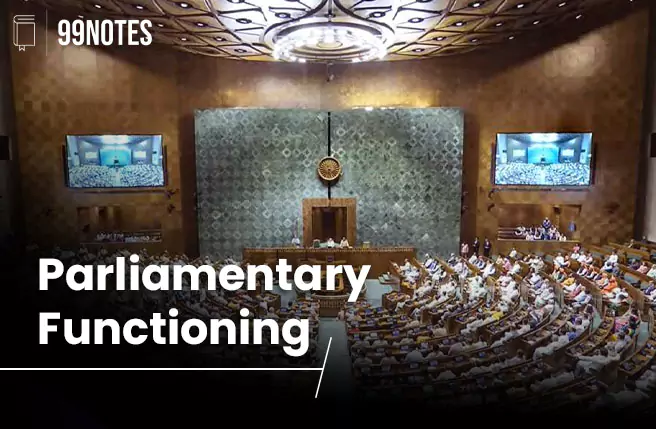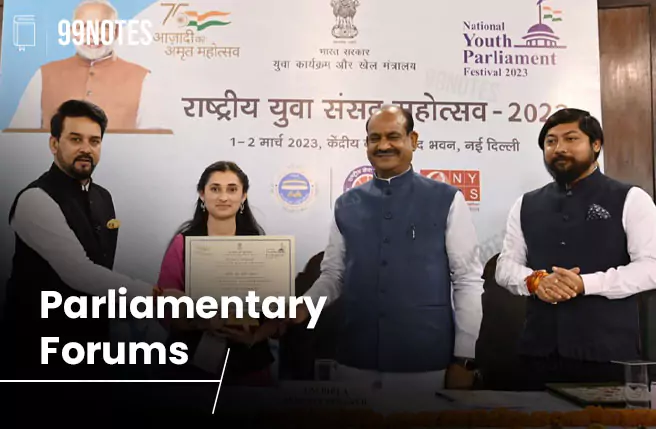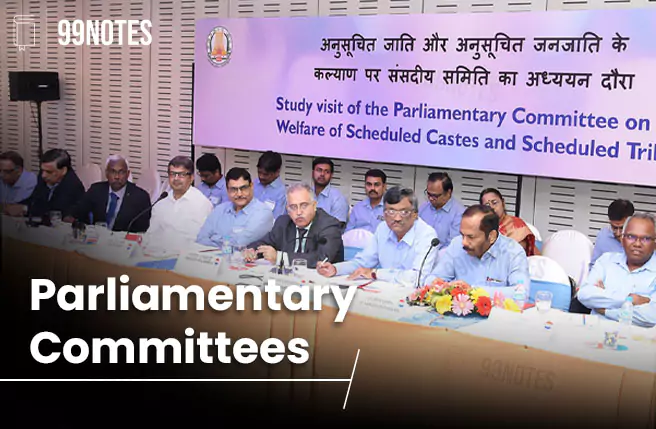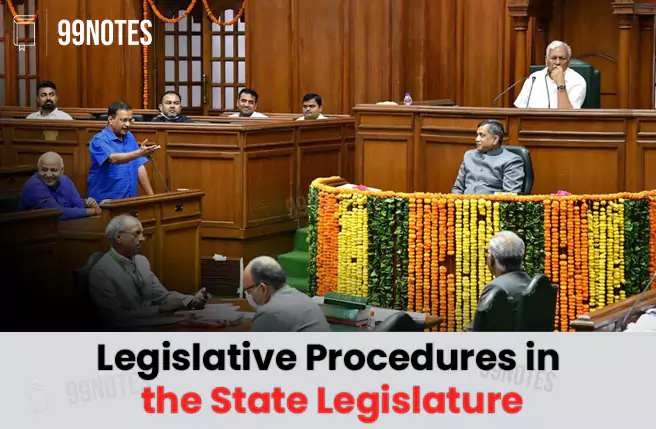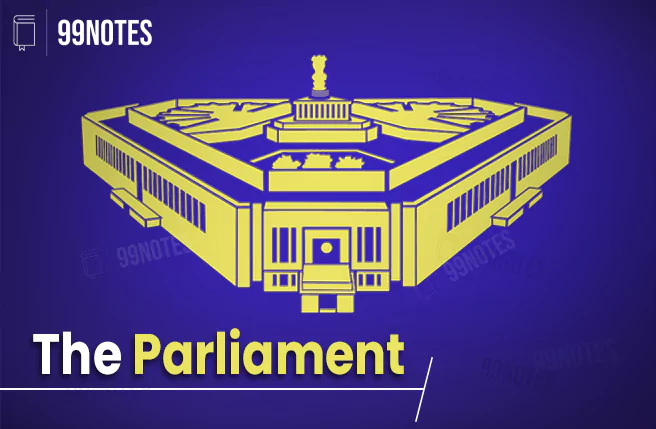Parliamentary Functioning UPSC Notes
Functions of the Parliament
In order to perform its role efficiently, various mechanisms have been set up in the Constitution, and each House has been empowered to make its own rule under Article 118. Rules of communication between both houses and the Joint sitting are made by the President after consultation with the Speaker of Lok Sabha and the Chairman of Rajya Sabha.
Using these constitutional powers, the ‘Rules of Procedure and Conduct of Business in the House of the People’ and ‘Rules of Procedure and Conduct of Business in the Council of States’ have been made by each House. These mention the various aspects of parliamentary functioning, which include summoning of the Parliament, Quorum, Language and various devices of parliamentary proceedings.
Sessions of Parliament
As per Parliamentary convention, there are generally three sessions of the Parliament: budget, monsoon, and winter. Besides, these special sessions can also be called for specific purposes. However, the gap between the two sessions cannot exceed 6 months.
A ‘session of House’ spans from the first sitting of the House to its prorogation (end of the session). The period between the prorogation and reassembly of the House is called ‘recess’.
Summoning
The President summons both Houses of the Parliament to meet. In both Houses, the Secretary General of the respective Houses is responsible for issuing summons to the members, specifying the date and place of the session. Rules of procedure mention no time limit between the issue of summon and the date of session.
The President issues summons with the aid and advice of the Council of Ministers. It means the power to call the session is with the government, giving it some control over the Legislature.
Termination of sittings of Parliament
The Presiding Officers can terminate the sitting of Parliament in the following three ways:
- Adjournment: It suspends the sitting of the House for a specified amount of time; it could be a few hours, days or weeks. Generally, at the end of each day, the House is adjourned to meet again on the next day. Sometimes, however, during an uproar in the Parliament, it can be adjourned for a few hours with an intention to resolve the issues.
- Adjournment Sine Die: It means terminating the sitting of the Parliament for an indefinite amount of time. It does not end the session, which means the presiding officer can call the sitting of the House at any time without having to opt for a formal summons that can be issued only by the executive.
- Prorogation: Prorogation means the end of the session. The President is empowered to prorogue the House while in session. After prorogation, no sitting can be called by the Presiding officer, and to hold a new sitting, a fresh summon by the President would be required.
Generally, when the presiding officer intends to end the session of the House, they declare the House adjourned sine die, after which the President prorogues the session of the Parliament.
Lame Duck Session |
| It is based on a tradition in the US Congress in which the last session of the existing Lok Sabha is conducted after the new Lok Sabha has been constituted. Those who could not get re-elected are known as Lame-ducks. |
President’s Address to Parliament
Article 87 provides for the President’s address in Parliament on two occasions.
- President addresses the Lok Sabha and Rajya Sabha jointly at the beginning of the first session of the newly constituted Lok Sabha.
- President also addresses the Parliament at the beginning of the first session of each year.
The address highlights the broad agenda, achievements, and upcoming government policies.
Motion of thanks: After each Presidential address, a motion to thank the President for his/her address is moved in both houses in which the content of the address and work of government is discussed. The discussion concludes with a reply from the Prime Minister in both houses. The motion is then put to vote.
Dissolution of the Lok Sabha
Dissolution of the House (only Lok Sabha) leads to the end of the life of the House, and it is reconstituted after general elections. Rajya Sabha, being a permanent body, is not subject to dissolution.
The dissolution of Lok Sabha can happen in the following situations:
- On expiry of the tenure of Lok Sabha after 5 years;
- Or, it can be dissolved at any time by the President on the aid and advice of the PM and the Council of Ministers.
Effects on bills post-dissolution of Lok Sabha
- The bills pending in the Lok Sabha lapse (Whether initiated in the Lok Sabha or communicated to it by the Rajya Sabha).
- A bill passed by the Lok Sabha but pending in Rajya Sabha lapses.
- A bill for which holding a joint sitting of both houses is notified by the President does not lapse.
- A bill initiated and pending in Rajya Sabha does not lapse.
- A bill for which the President’s assent is pending does not lapse.
- A bill passed by both houses but sent back by the President for reconsideration does not lapse.
Quorum in the Parliament
The quorum refers to the minimum number of members required to be present in the House for it to function and transact any business. It is a protection against any unrepresentative action by a small group.
- The quorum in each House has been fixed at 10% of the members of the House, including the presiding officer. [Article 100 (3)]
- It means the Lok Sabha must have 55 members present in the House, and the Rajya Sabha must have 25 members present for the House to function.
- The Constitution under Article 100 (4) requires the presiding officers to either adjourn the Houses or suspend the meeting until the quorum is restored.
Language in the Parliament
Article 120 of the Constitution provides for the Language of the Parliament, according to which the following provisions are made:
- Hindi and English are to be used as the languages for business transactions in Parliament.
- The Presiding officers may permit the members to express themselves in their mother tongue.
- The use of English was to continue for 15 However, the Official Languages Act 1963 allowed the use of English for an indefinite period.
Rights of Ministers and Attorney General in Parliaments
A minister is answerable to the Parliament, both individually as well as collectively as a part of the council of ministers. In this context, the following rights are given to the ministers:
- A Minister is entitled to attend the meetings and speak in any House of the Parliament, irrespective of membership. Although s/he can vote only in that House of which s/he is a member.
- A minister who is not a member of any House can also participate and speak in both Houses (although s/he has no right to vote). Remember, a person can become a minister for 6 months without becoming a member of any house.
Further, despite not being a member, the Attorney General also has the right to participate and speak in the proceedings of both Houses as well as the joint session and Parliamentary Committees of both Houses.
Devices of Parliamentary Proceedings
1. Question Hour
Generally, the first hour of a sitting of the Parliament is devoted to Questions, and it is called the Question Hour. During this period, the members can ask questions on every aspect of administration and government activity from concerned ministers (irrespective of the minister’s membership).
These questions allow the government to sense the popular perception regarding their policies; it can also bring out certain shortcomings that need rectification.
The questions have been classified into Starred, Unstarred, Short Notice Questions and Questions addressed to Private Members.
- Starred: In this type, the member demands an oral answer and can also ask supplementary questions. It is marked by an asterisk sign (*).
- Unstarred: In this type, a written answer is laid on the table, and no supplementary questions can be asked.
- Short notice questions: These questions are related to matters of urgent public importance and require short notice (less than 10 days). These questions are required to be answered orally.
- Questions addressed to private members: These questions are asked by a member to another member of the House. It can be related to a bill, resolution or any other business of the House.
2. Zero Hour
Zero hour is a Parliamentary innovation; it is not mentioned in the Rules of Procedure. This is a parliamentary device to raise important issues of public importance by giving advance notice. It starts immediately after the question hour and continues till the regular business of the House starts.
Motions
Motion means a proposal made with the intention to get a response from the Parliament on any matter. The Parliament decides every matter in the form of a motion, moved with the permission of the Presiding officer.
The motions in the Parliament can be mainly categorised into 3 types:
- Substantive Motions: These are self-contained and independent proposals, designed in such a way that they express the decision of the House. All resolutions are substantive motion For example- A no-confidence motion and a motion for impeachment of the President.
- Substitute Motions: Such motions are moved in substitution of the original motion and seek to amend the original motion. It is discussed along the original motion. If it is adopted, it supersedes the original motion.
- Subsidiary Motions: These are not original motions and either depend upon or relate to another motion. They themselves do not carry any meaning and cannot get the House to express its decision unless linked with the original motion.
Subsidiary motions can be further divided into:
- Ancillary Motions: These are motions that are recognised by the practice of the House as the regular way of proceedings with various kinds of business. For example, (a) that the Bill be taken into consideration, (b) That the Bill be passed.
- Superseding Motions: These are moved in the course of a debate on another question and seek to supersede the question. For example- an original motion such as “that the bill be taken into consideration can be superseded by a motion such as “that the Bill be re-committed to a Select Committee”.
- Amendments: These motions seek to modify or substitute a part of the original motion.
Adjournment Motion
Under this motion, the scheduled business of the Lok Sabha (this motion is not allowed in Rajya Sabha) is set aside for discussion on matters of urgent public importance. Though the adoption of the motion does not lead to the fall of the government, it is a strong censure of the government.
- It needs the motion to be moved by at least 50 members;
- The Speaker can either reject the motion or allow it.
- The discussion on the matter lasts for not less than 5 hours.
The rules of procedure have put the following restrictions on moving an adjournment motion:
- Only one such motion can be moved in one sitting;
- Only one issue can be discussed in a motion;
- The motion should be related to important matters of recent occurrence and related to the central government.
- It should not raise a matter of privilege;
- It should not be about any issue which has been discussed in the same session;
- It should not be about any matter sub judice in any court of law;
- It should not involve an issue that can be raised by only a certain type of motion.
No-Confidence Motion
As we know, the Council of Ministers is collectively responsible to the Lok Sabha and stays in office as long as it enjoys the confidence of the House (Article 75). A no-confidence motion is moved to test the confidence of the Lok Sabha in the Council of Ministers.
- The motion needs the support of at least 50 members to be admitted, and the Speaker may admit or reject the motion.
- After the motion is admitted, a discussion takes place on the government’s functioning and its shortcomings.
- After the discussion, the motion is put to vote; if approved, it leads to the resignation of the ministry.
Closure Motion
This motion is moved by a member to cut short the debate on a particular issue. If adopted, the debate is stopped, and the question of the debate is put to vote. The motion can be categorised into 4 parts:
- Simple Closure: When a member moves a motion that the “matter has been sufficiently discussed be now put to vote”.
- Closure by Compartment: In this motion, the clauses of a bill or resolution are clubbed together and put to vote.
- Kangaroo Closure: As per this motion, only the important clauses of a bill or resolution are debated and put to the vote, skipping over the intervening clauses and considering them as passed.
- Guillotine Closure: Under this, the undiscussed clauses of the Bill are put to vote along with the passed ones due to paucity of time.
| Censure Motion No-Confidence Motion | |
| It can be moved against an individual minister, group of ministers or entire Council of Ministers. | It can only be moved against the entire Council of Ministers. |
| It requires a specific reason. | Does not need a reason for its adoption. |
| It is moved for censuring the government on specific policies. | It is moved to test the confidence of the House in the Lok Sabha. |
| If passed, it is considered a censure of the government. | If passed, it leads to the resignation of the ministry. |
Calling Attention Motion
It is moved to call the attention of a Minister to any matter of urgent public importance. It seeks an authoritative statement from the minister on any specific issue of public importance.
Privilege Motion
It can moved by a member against a minister if s/he feels that the minister has breached the privilege of a member, a group of members or the House by withholding any information or by presenting incorrect or distorted facts.
No yet Day Named Motion
The motions that the Speaker admits but no fixed date has been assigned for discussion are known as no yet day-named motions.
Other Parliamentary Devices
1. Point of Order
A member can raise a point of order if the functioning of the House is not in accordance with the rules of procedure of the House. It is an effective device in the hands of the opposition to control the government. If the point of order is raised, the proceeding is suspended till the issue is resolved.
2. Half-an-Hour Discussion
This provision is used when members feel that answers given by ministers were not sufficient, then they may be allowed by the presiding officer to raise a discussion in the House for half an hour. 3 days a week are allotted for such discussion. They are not followed by voting.
3. Short Duration Discussion
This is an important parliamentary device available to members to draw the attention of the government to matters of urgent public importance. Under this, the members can raise a discussion of short duration without a formal motion or vote thereon.
4. Special Mention/Notice
This device is used when a matter cannot be raised under point of order, question hour, adjournment motion, or other parliamentary devices. It was devised to formalise the system in which members can raise issues with the prior permission of the Presiding officer. A similar device in Lok Sabha is called ‘Notice’.
5. Resolutions
A resolution is a procedural device to raise a discussion in the House on a matter of general public interest. It should clearly express the issue and should not include more than one issue. It is a device to declare the opinion of the House on any issue.
The resolutions are classified into the following types:
- Private Member’s Resolution: It is moved by a private member. If it is adopted, it is not binding on the government.
- Statutory resolution: Such resolutions can be moved by both private members and ministers. They must be related to a provision of the Constitution or an act of Parliament.
- Government resolution: Such types of resolutions are moved by concerned ministers and, in his/her absence, any other minister on his/her behalf. For example- Resolutions concerning international treaties, conventions or agreements to which India is a party.
Resolution with a force of law: Although resolutions are not law, there are some categories of resolutions that have the force of law. They are binding on the government. For example, the resolution passed by the Parliament disapproving of the proclamation of Emergency.
Difference between a motion and a resolution
The difference between a motion and a resolution is more of a procedural nature than of content.
- By voting on a motion or resolution, the House declares its opinion on any subject, and it becomes the order of the House.
- All resolutions are substantive motions and are followed by voting.
- However, all motions are not substantive motions, meaning they do not necessarily require voting.
Conclusion: These Parliamentary functions have their own set of limitations, as we have discussed in the previous article. Frequent disruptions and the bipartisan role of the Speaker and Chairman are a few of the reasons behind such occurrences.

